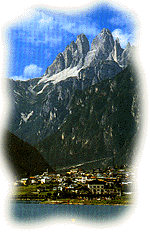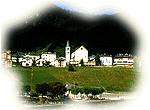 |


|
|
AURONZO DI CADORE |
|
| An ancient settlement with an active society of Roman character, Auronzo is now a town of about 4,000 inhabitants which stretches along more than eight kilometres of the longest valley in Cadore and is crossed by the Dolomites State Highway. The township incorporates eleven communities - Cima Gogna, Cella, Villapiccola, Villagrande, Riziò, Reane, Pause, Ligonto, Giralba, San Marco and Misurina - bordering on the north with the southern moderate slopes of Mount Aiarnola , and on the south with the lake of Santa Caterina. The lake, fed by the Ansiei stream, was formed in the 1930s following the construction of an ENEL dam and turned Auronzo into a beach town where major motor-boat and canoe races take place. Offering fine accommodations and sports facilities and established as both a summer and winter resort, Auronzo also takes pride in its flourishing eyeglass industry and sawmills. The town is an extremely eclectic amalgamation of architectural styles, with older and restored edifices contrasting with more recent buildings - such as City Hall and numerous villas. An outstanding structure is the 18th-century parish church of Santa Giustina at Villagrande, perhaps the largest place of worship in all Cadore, with an aisleless nave and marble altars. Noteworthy are also the church of San Lucano at Villapiccola, built in the Neo-Classical style by Segusini, and the 16th-century small church of Santa Caterina at Cella. The city extends over an area of 22,000 hectares along the Ansiei stream in a valley covered by green meadows and woods and tabià, the colourful local hay-lofts made in wood. As a backdrop to the town rise mountains such as the Tre Cime di Lavaredo ("Three Peaks of Lavaredo"), the Cadini, the Croda dei Toni, and the Corno del Doge - which explains why the town is a sort of paradise for mountain-climbers and why it was the subject of ferocious disputes during the First World War. The Auronzo landscape inspired the fascinating legend about two young girls: Agonia, tied to Attila the Hun, and Misurina, whose tears created the Misurina Lake. A must in any tour of Palus San Marco (1,100m) is an invigorating walk in the woods among the fir and larch trees in the Somadida Wood, which in 1463 was donated by the Cadore people to Venice to help it build its ships. During the rule of the Serenissima Republic of Venice, Auronzo was famous also for its mines, now closed, such as that of Argenteria (of particular archaeological and industrial interest), Ferrera, Grigna Pian de Barco and Colle di Villagrande, where lead, zinc and a bit of silver were extracted. Reference to these mines appears in a document by Emperor Berengario dating as early as the 10th century.
|
||



 APT
APT